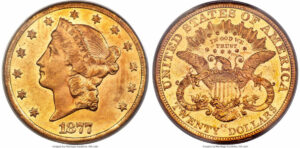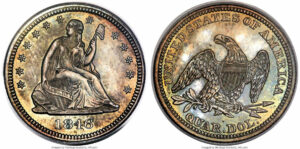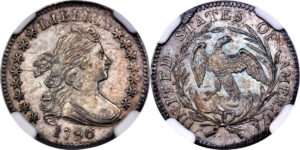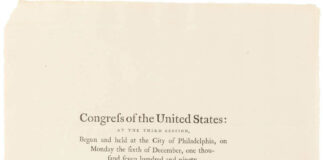Carson City $20 Gold Coin Sold for $1.62 Million at Heritage Auctions
Heritage Auctions’ 11th to 14th November 2021 US Coins Signature® Auction was rich with numismatic must-haves, from the earliest U.S. coins to Old West wonders to modern marvels. Collectors responded accordingly: More than 3,000 bidders spent $11,432,236 during the near-complete-sell-out four-day event, setting one world record and exceeding expectations on numerous occasions.

In fact, during the very first night of the event, a fierce bidding war drove the final price of an 1870 gold coin to a world record, as an 1870-CC $20 Liberty from The Prestwick Collection sold for $1,620,000. It should come as no surprise, as Carson City gold is well known as an avidly collected area of United States numismatics – and the $20 Liberty that sold Thursday is one of the rare survivors out of the 3,789 reportedly minted. And, graded AU53, it’s the finest certified at PCGS.
But it was not alone in drawing collectors’ rapt attention: During the auction, two other Carson City gold pieces from the same collection likewise sold for substantially more than expected. One of them, an 1872-CC double eagle $20, realized $144,000. Unlike the 1870-CC $20 Liberty, the 1872-CC is not a legendary rarity; it comes from a mintage of 26,900 pieces. Its high price can be attributed to the fact that it’s graded NGC MS61, and there exist but two coins certified finer.

An 1877-CC Liberty Double Eagle, graded MS62, likewise sold for $144,000, and is highly regarded as a scarce Carson City date; this coin, too, is tied for the finest certified, making it a valuable addition to a collection. It’s also a historic piece, as the design of the double eagle was slightly modified in 1877: It actually spelled out TWENTY DOLLARS, replacing the TWENTY D. featured previously. This new design, known as the Type Three Liberty double eagle to present-day collectors, represents the only major design modification of U.S. gold coinage that took place during the years the Carson City Mint was operational.
But all that glittered from The Prestwick Collection and Carson City in this auction wasn’t necessarily gold: an 1875-CC 20 cent piece, graded MS66, sold for $84,000. The 20 cent denomination wasn’t well-received upon minting – in part because it closely resembled the quarter dollar – and some of the coins were retained by the mint until they were eventually melted in May 1877 upon orders from the mint’s director. But time heals all wounds, as evidenced by this rarity’s popularity in this auction. “The market for Carson City coinage continues to be very active, especially for scarce dates or top-grade examples,” says Sarah Miller, Heritage Auctions’ Senior Vice President and Deputy Managing Director of the New York Office. “CC $20s in particular led the charge with strong bidding, as these three offerings from The Prestwick Collection soared past anticipated levels to find new homes with passionate collectors.”

Two early proof coins also sold well above pre-auction expectations. Both coins date from the mid-1800s, making them exceptionally rare, as proof coins were not regularly issued by the U.S. mint until about 1860.
One, an 1846 Liberty Seated quarter graded PR64, sold for $21,000. No mintage figures were recorded for this 1846 proof, but the production total was undoubtedly small – so small, in fact, that Seated quarter specialist Larry Briggs estimates only 10-12 specimens survived, while PCGS CoinFacts estimates an even smaller surviving population at 8-10 examples, in all grades. Heritage catalogers have traced 13 pieces that we believe are different examples, including one in the National Numismatic Collection at the Smithsonian Institution. And an 1855 Arrows dime, graded PR64, brought $16,800, befitting its status as a Rare Cameo Example. This one, too, is extremely rare in all grades: PCGS CoinFacts estimates the surviving population at 15-20 examples.

Offerings, too, from the earliest days of the United States Mint proved popular during this auction, among them a 1796 Draped Bust dime graded MS63 that is one of only two known coins struck from the terminal die state with a triangular cud over the first T in STATES. This renowned coin – which is pedigreed to the Dr. George P. French, T. James Clarke, Lester Merkin, John Walter Whitney and Eugene Gardner collections – sold for $43,200.
Modern offerings likewise thrived among the Colonial and Old West coins offered last weekend. That included a 1964-D/D Jefferson nickel that brought $9,000 thanks to the repunched mintmark plainly visible beneath a loupe on this popular Cherrypickers’ variety. This is a high-end, brilliant and appealing example. PCGS has attributed only six examples of this variety in all grades.
“We were very happy to see the level of collector participation in this auction across the board,” Miller says. “The history of this country is uniquely told through its coins, and Heritage Auctions is proud, as ever, to present these momentous offerings to collectors eager to own a piece of that story.”
On Heritage’s website you can find all results from the auction.
For further information about the auction house, visit the website of Heritage Auctions.





